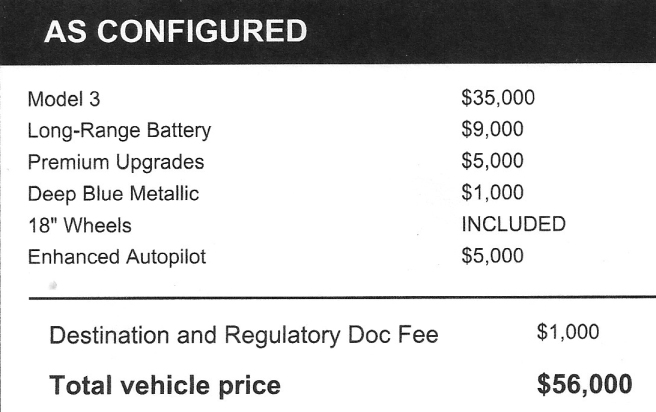On March 31, 2016, I went to the local Tesla store to plunk down a $1,000 deposit on the long-anticipated Model 3. No one had seen one, let alone driven one. There was a line out the door and down the street and I soon learned it wasn’t moving much. There were probably 100+ people in front of me, so I left, went home, and made my deposit from home later that evening. I was probably more than #100,000 of the 180,000 who gave deposits in those first 24 hours, so I figured I’d be waiting a while.
In March 2018, 24 months after all those Day One deposits, it looked like Tesla was getting ready to deliver Model 3s to new customers. They had been slowly delivering cars to some employees and existing owners of other models for the previous six months or so. Hoping I’d get to configure my car soon, I rented a Model 3 for 24 hours from a Tesla employee via Turo. My wife and I ran some errands and put about 100 miles on it. The car was everything I’d hoped for.
26 months after paying the deposit, and after checking the Tesla website many times each day, I discovered I could now configure my car. Of course I’d been planning my configuration for some time, and I was pleased to discover that my chosen config was identical to the first version of the car Tesla was producing. It would be the only configuration (except for color, wheels, interior and autopilot options) available for the first three months.

You can see the config from the delivery sticker.
- Basic Model 3 with Rear Wheel Single-Motor Drive (standard). 0-60mph in about five seconds. $35,000
- Long-Range Battery. 310 miles vs. 220miles for the standard battery. $9,000 upgrade.
- Premium Upgrades. Power, heated seats; center console; premium audio system (excellent!), tinted glass roof; dimming/folding/heated side mirrors; driver profiles; LED fog lamps. $5,000 package.
- Deep Blue Metallic paint. An extra $1,000 for those shiny little flakes.
- 18″ Standard Wheels with the removable Aero covers.
- Enhanced Autopilot. $5,000. Doesn’t include the future Full Self-Driving Capability, but does include (today!) Auto Lane Change, Autosteer (stay in lane), Traffic-Aware Cruise Control (great for stop-and-go traffic), Autopark (parallel and back-in) and Summon (in and out of the garage, for example).
- Total $56,000 plus tax and license.
So what didn’t I get?
- Full Self-Driving Capability. It’s a $3,000 increase, or pay $5,000 to update at a later date. This is a “future” feature. It doesn’t exist yet. Given the complexity of the task and all of Tesla’s many delays, I figure I might not still own the car by the time they offer this. So I opted out at this time.
- Dual-Motor All-Wheel Drive. 0-60mph in about 4.5 seconds. $4,000 increase. I don’t need to drive in snow, mud, etc.
- “Performance” Dual-Motor All-Wheel Drive. 0-60mph in 3.5 seconds. A $15,000 upgrade over the base price or $11,000 more than the non-performance AWD version. I had driven a basic rented Model 3 two months prior, so I knew the basic car was plenty fast enough for me.
- 19″ Sport Wheels. $1,500 upgrade. The standard 18″ wheels offer a smoother ride. Besides, I like the looks of both the standard Aero covers as well as the standard wheel that’s underneath if you remove the Aeros.
- Premium White Interior. $1,500 upgrade. White? Really?
And what do I think after three months (although admittedly, I still haven’t driven my own car)?
I’m quite happy with the choices I made. The only one I even question is the $9,000 long-range battery. That’s a big chunk of change, particularly considering that the 220-mile battery would probably be just fine for me except for 4-6 days per year when I might make a long trip to Oregon or Southern California. That standard battery still isn’t supposed to be available for another 6-9 months (ie, 2019Q1 or Q2), and since my old car (a Lexus 450X) was totaled in May, I’d have had to buy something else in the meantime. All things considered, I’m very happy to have the long-range batteries.